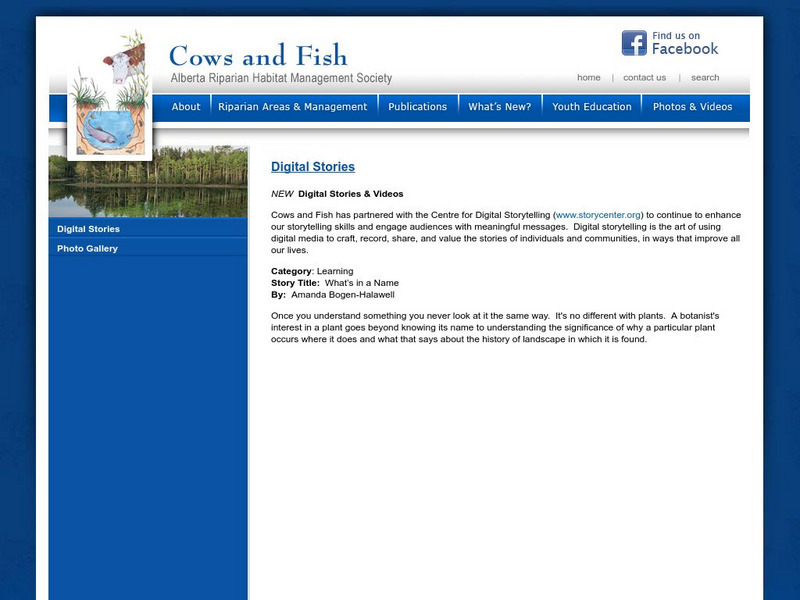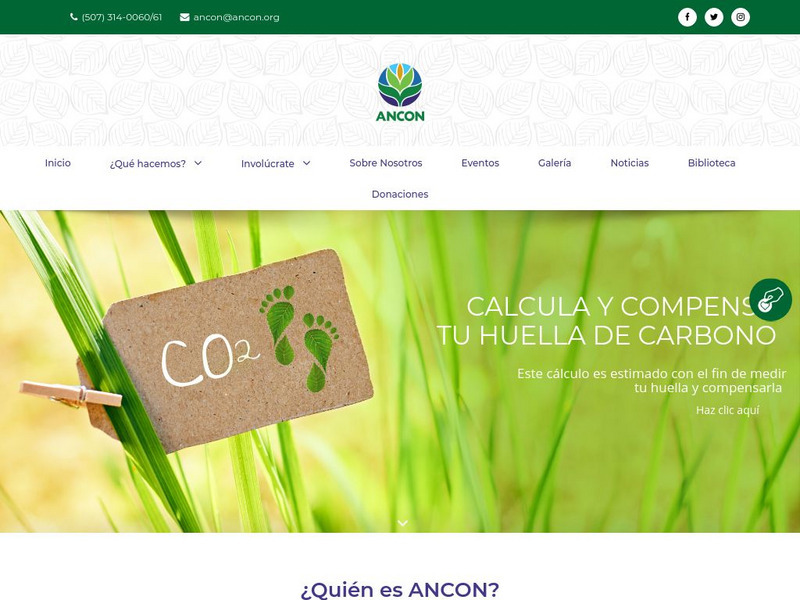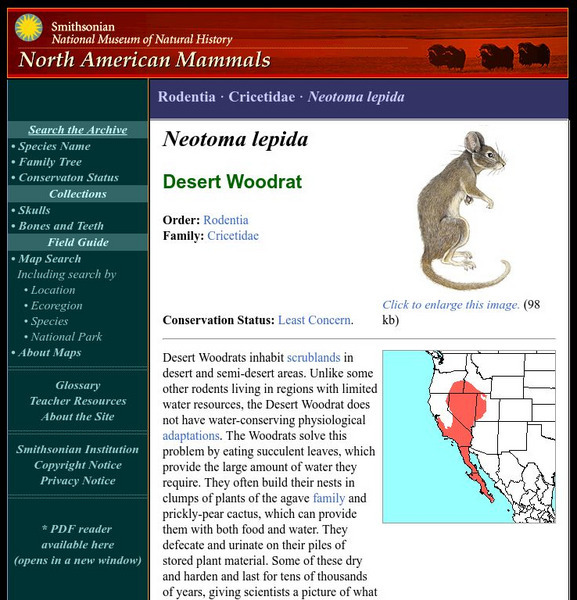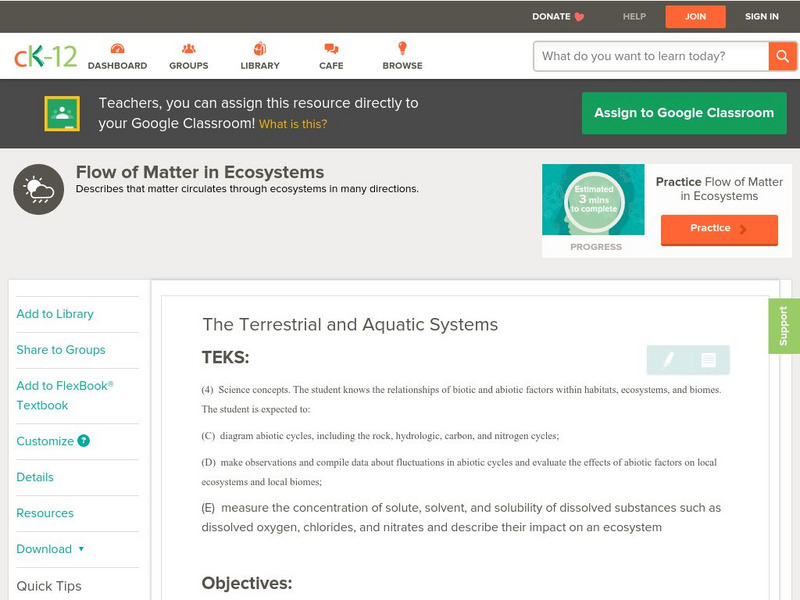Hi, what do you want to do?
Other
Alberta Riparian Habitat Management Society: Digital Stories
A selection of good-quality videos that teach about riparian areas are available here. The videos promote an understanding of riparian shorelines and explain the importance of preserving these areas.
Other
Alberta Riparian Habitat Management Society: Photo Gallery
By registering on this website, you gain access to a collection of photos of riparian areas in Alberta that can be used for educational purposes.
Other
Linking Environment and Farming: Simply Sustainable Soils [Pdf]
With increasing pressure on the world's natural environment and resources it is essential that we develop farming systems that have a low impact on the environment, and are also highly productive in meeting the needs of a growing global...
American Geosciences Institute
American Geosciences Institute: Earth Science Week: Mapping Your Soil
Use the Web Soil Survey developed by the USDA-Natural Resources Conservation Service to determine what soil is around your school and how it can be used.
Other
Ancon Homepage
This is the homepage of ANCON, an environmental organization whose goal is to conserve the biodiversity and natural resources of Panama. The page contains links to learn more about their organization as well as beautiful pictures of the...
Alabama Learning Exchange
Alex: Save the Forest
President Theodore Roosevelt believed in the need for conservation and was called America's first environmental president. What steps did he take to help preserve the environment and its natural resources? Today we can enjoy the beauty...
Smithsonian Institution
National Museum of Natural History: American Mammals: Desert Woodrat
Desert Woodrats inhabit scrublands in desert and semi-desert areas. Unlike some other rodents living in regions with limited water resources, the Desert Woodrat does not have water-conserving physiological adaptations. Learn more about...
Other
Hilton Pond Center
This Hilton Pond Center site is a resource for teachers, students and researchers who are interested in the environment and environmental conservation of animals and plants.
CK-12 Foundation
Ck 12: Earth Science: Flow of Matter in Ecosystems
[Free Registration/Login may be required to access all resource tools.] In this module, students will learn about the cycles of nature (water, carbon, nitrogen, and phosphorus) that support the flow of nutrient matter through an...
Nature Canada
Nature Canada: Canada's Boreal Forest
A look at Canada's Boreal Forest ecosystem. One of the largest ecosystems in the world, it provides abundant fresh water for North America and is home to many species of wildlife, for example, wolves and caribou. There is also discussion...
US Geological Survey
Usgs: Water Science for Schools Activities Center
This website offers three activity centers: Questionnaires, Opinion Surveys, and Challenge Questions. Take a look at these interesting water research activities from the US Geological Survey. Click Home to access the site in Spanish.
Other
Fundacion Vida Silvestre Argentina
This Spanish language page is the on-line home of the Argentinian Wildlife Foundation or the Fundacion Vida Silvestre Argentina, that presents information about biodiversity in Argentina and efforts to protect it.
Pennsylvania Historical and Museum Comission
Explore Pa History: Pennsylvanians and the Environment
Discover the relationship between Pennsylvanians and the environment through this detailed, historical account which contains links to audio, video, pictorial images of the era.
Alabama Learning Exchange
Alex: Endangered Species
Young scholars research and create a brochure project on an endangered species of their choice integrating aspects of math, science, social studies, art, reading and writing. This project allows the students to make connections across...
Scholastic
Scholastic: Study Jams! Science: Energy, Light and Sound: Fossil Fuels
A slideshow and a short quiz on the types of fossil fuels we use and the impact this has on the environment.
PBS
Pbs Learning Media: Wolong's Pandas
Wild pandas are treated at the Wolong Conservation Center in this video segment from Nature.
PBS
Wnet: Thirteen: Eco Challenges
Research and report on two pressing environmental concerns in Africa: the scarcity of clean water and the desertification of farmland. Respond to these issues through activities involving art, drama and journalism.
Text Project
Text Project: Fyi for Kids: Counting Endangered Animals [Pdf]
This FYI for Kids (Volume 5, Issue 2) article focuses on counting endangered animals including how they count them and why. It uses two examples of the use of modern technology to count endangered animals: panthers and humpback whales.
TeachEngineering
Teach Engineering: Designing a Sustainable Guest Village
This lesson plan introduces young scholars to their task of designing a permanent guest village within the Saguaro National Park. The design must provide a true desert experience to visitors while also emphasizing sustainable design,...
US Environmental Protection Agency
Epa: Land, Waste, and Cleanup Topics
This site is loaded with information on solid waste and hazardous waste. It includes industries' effects on the environment, waste programs, treatment, control, pollution prevention, recycling, and cleanup programs.







![Linking Environment and Farming: Simply Sustainable Soils [Pdf] Article Linking Environment and Farming: Simply Sustainable Soils [Pdf] Article](https://static.lp.lexp.cloud/images/attachment_defaults/resource/large/FPO-knovation.png)












